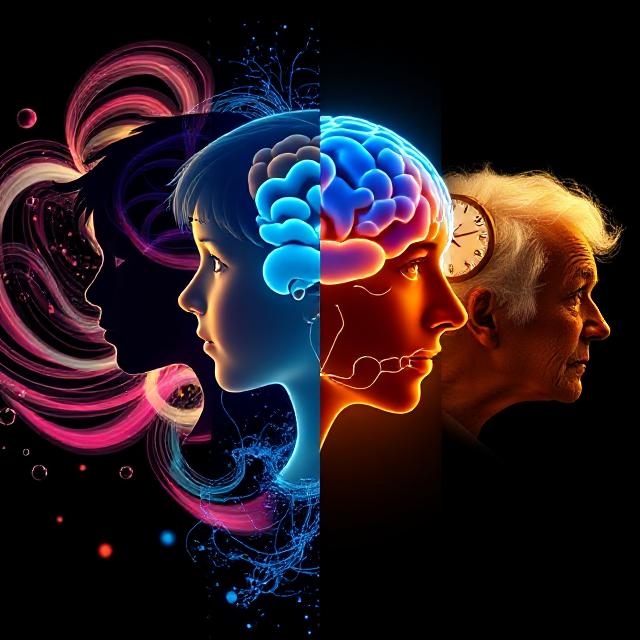
Table of Contents
How Brainwaves Shift with Age: Focus vs Memory
Your brain is electric—literally. Every thought, focus session, memory, or daydream rides on rhythmic waves of neural activity. But those brainwaves don’t stay the same throughout life.
From the fast, scattered rhythms of childhood to the deep, meditative waves of later years, your brainwave profile evolves with age—and with it, your mental strengths and vulnerabilities.
This article breaks down:
- How each brainwave type changes across the lifespan
- What that means for focus, memory, learning, and emotional regulation
- How to train brainwave balance at any age
- Early signs of dysregulation—and how to support a resilient brain
Understanding the neural rhythm of aging offers powerful insight into cognitive health—and tools to enhance performance at every stage of life.
🧠 Brainwave Primer: The Cognitive Roles of Each Band
Here’s a quick reference chart for the core types of brainwaves:
| Brainwave | Frequency | Role |
|---|---|---|
| Delta | 0.5–4 Hz | Deep sleep, cellular repair, unconscious integration |
| Theta | 4–8 Hz | Creativity, memory consolidation, meditative states |
| Alpha | 8–12 Hz | Relaxed alertness, readiness to learn, internal attention |
| Beta | 12–30 Hz | Focus, task engagement, cognitive control |
| Gamma | 30–100 Hz | High-level synthesis, insight, sensory integration |
Now let’s look at how these evolve over time.
👶 Childhood: High Theta, Rapid Switching
In young children, brain activity is dominated by slow waves—especially theta and delta. This is why kids seem imaginative, dreamy, and open to learning through experience and play. However, they often struggle with:
- Sustained attention
- Delayed gratification
- Filtering distractions
Their brains are still learning how to generate and stabilize beta waves, the rhythms associated with focused thinking.
EEG studies show that beta power steadily increases from early childhood to adolescence, tracking with gains in attention, impulse control, and reasoning.
Memory in children tends to be episodic and emotionally linked, often encoded during theta-rich moments—stories, songs, movement.
🧑 Teen & Young Adult Brain: Beta Rising
Adolescence brings a surge in beta activity, correlating with:
- Improved attention span
- Task switching
- Abstract reasoning
- Verbal fluency
But it also brings volatility. Stress, hormones, and sleep deprivation can spike high beta (associated with anxiety) and suppress restorative alpha or theta states.
At this stage, memory is sharp, especially for emotionally charged or novelty-based experiences. The gamma wave network also becomes more functional, allowing for better sensory integration and decision-making.
Fun Fact: College-aged adults show peak performance in working memory and fast learning, especially when beta and alpha are well-balanced.
👨🦱 Midlife: Efficiency vs Overload
By your 30s and 40s, your brain begins prioritizing efficiency over speed. Beta waves remain strong, but alpha power becomes crucial for:
- Filtering distractions
- Accessing long-term memory
- Managing stress
During this phase, overtraining beta (e.g., from work pressure or constant digital stimulation) can lead to:
- Focused fatigue
- Brain fog
- Sleep disturbances
Meanwhile, gamma coherence (integrating information across the brain) tends to peak around midlife, especially in those who engage in deep learning, meditation, or creative work.
Midlife success relies on learning to cycle between high-focus states and deep rest to preserve cognitive flexibility.
🧓 Later Years: Slow Waves and Memory Shifts
After age 60, brain rhythms start to slow overall. Here’s what typically happens:
- Delta and theta increase (more internal reflection, less external focus)
- Beta and gamma power decrease (slower processing, reduced attention bandwidth)
- Alpha amplitude may weaken, affecting information filtering and retention
This shift affects short-term memory, multitasking, and mental agility. However, long-term memory, emotional intelligence, and pattern recognition often remain robust.
EEG studies show that older adults compensate by using more of their brain at once—recruiting additional regions during tasks younger brains handle locally.
Sleep quality also affects brainwave stability. Poor delta sleep can accelerate cognitive decline, while preserved slow-wave sleep supports brain detox (via the glymphatic system) and memory consolidation.
🔄 What Causes Brainwave Dysregulation With Age?
While aging itself causes shifts in brainwave dominance, several lifestyle and environmental factors can accelerate the decline or preserve optimal rhythms:
| Disruptor | Impact |
|---|---|
| Chronic stress | ↑ High beta → anxiety, ↓ alpha → poor learning |
| Sleep deprivation | ↓ delta and theta → memory and mood issues |
| Sedentary lifestyle | ↓ gamma and alpha → lower integration, emotional flatness |
| Nutritional imbalances | ↓ magnesium, omega-3s → disrupted rhythm control |
| Toxin exposure (e.g., heavy metals) | EEG slowing, reduced coherence |
These disruptions can mimic or accelerate cognitive aging—but they’re often reversible with targeted intervention.
🧘♀️ Brainwave Training: Stay Sharp at Any Age
The good news? Brainwaves are trainable. Here are age-appropriate interventions to enhance cognitive clarity and memory:
For Young Adults
- Pomodoro + alpha breathing to train focus cycles
- Binaural beats for exam prep (e.g., beta/alpha blends)
- Mindful breaks to prevent beta overload
For Midlife
- Neurofeedback for alpha/beta balance
- Cold exposure or fasting to sharpen theta-gamma coupling
- Flow-based learning (e.g., syntopic study, novelty immersion)
For Seniors
- Meditation for theta-delta stabilization
- Sleep syncing with circadian-friendly meals and light exposure
- Light movement + music to increase gamma activity
🧭 Final Reflection: A Rhythm-Based View of Cognitive Aging
We often measure cognitive health by scores and memory tests—but your brain’s rhythm tells a deeper story.
Whether you’re 18 or 80, knowing how your brainwaves shift with age helps you work with your neurology, not against it.
Focus isn’t just about effort—it’s about tuning.
Memory isn’t just about repetition—it’s about rhythm.
Stay in tune with your brain, and you’ll extend your clarity, creativity, and joy far beyond the typical cognitive curve.
